‘White,’ ‘Brown’ to Remain Lowercase
What the N.Y. Times Said in 1930 About ‘Negro’
Homepage “B” image credit: Leo Reynolds/Flickr

‘White,’ ‘Brown’ to Remain Lowercase
The New York Times Tuesday announced that it will join the growing list of news organizations capitalizing the “B” in “black” to describe “people and cultures of African origin, both in the United States and elsewhere.”
It will not capitalize “white” or “brown” in discussing races of people, and all of the terms will be used as adjectives, not nouns, when referring to human groupings.
The Times decision is especially significant because the Times’ 1930 bow to demands to capitalize “Negro” is viewed as a milestone in African Americans’ attempts to empower themselves through language.
The note to employees from Executive Editor Dean Baquet and Phil Corbett, associate managing editor for standards, said, “We have talked to more than 100 staff members to get their views, reviewed the arguments that have been made over many years, and consulted with colleagues at other news organizations. The feedback has been thoughtful and nuanced, with a wide range of opinions among colleagues of all backgrounds.”
In an Apple longform podcast posted Friday, Baquet described the newsroom discussion on capitalization as a “fierce debate” with not all younger black staffers agreeing that the word should be capitalized.
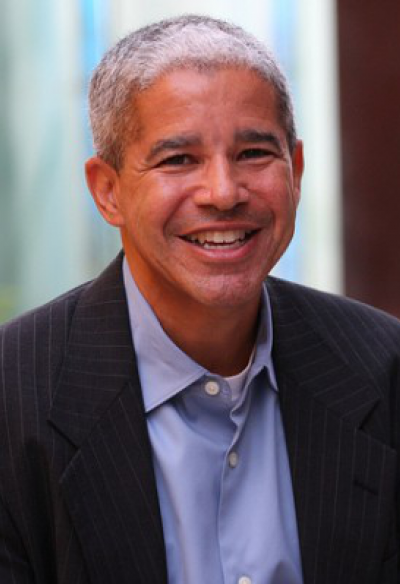 National Editor Marc Lacey (pictured) who led that discussion, messaged Journal-isms on Tuesday, “There were many conversations over this and many views, and most people in the newsroom who I spoke to supported it, especially Black journalists. But not everybody thought it was an essential style change and some people expressed discomfort with having a different style for Black and white.”
National Editor Marc Lacey (pictured) who led that discussion, messaged Journal-isms on Tuesday, “There were many conversations over this and many views, and most people in the newsroom who I spoke to supported it, especially Black journalists. But not everybody thought it was an essential style change and some people expressed discomfort with having a different style for Black and white.”
The final decision, according to Baquet’s and Corbett’s memo, was that, “We believe this style best conveys elements of shared history and identity, and reflects our goal to be respectful of all the people and communities we cover.”
The style change does not affect its use of the hyphen in “African-American,” though that term’s 1980s proponents intended not to have one and the Associated Press acceded to that last year after three decades.
“The change will match what many readers are seeing elsewhere. The Associated Press and other major news organizations have recently adopted ‘Black,’ which has long been favored by many African-American publications and other outlets. The new style is also consistent with our treatment of many other racial and ethnic terms: We recently decided to capitalize ‘Native’ and ‘Indigenous,’ while other ethnic terms like ‘Asian-American’ and ‘Latino’ have always been capitalized.
“We will retain lowercase treatment for ‘white.’ While there is an obvious question of parallelism, there has been no comparable movement toward widespread adoption of a new style for ‘white,’ and there is less of a sense that ‘white’ describes a shared culture and history. Moreover, hate groups and white supremacists have long favored the uppercase style, which in itself is reason to avoid it.
 “The term ‘brown’ as a racial or ethnic description should also generally remain lowercase and should be used with care. ‘Brown’ has been used to describe such a disparate range of people — Latin, Indigenous, Asian, Middle Eastern — that the meaning is often unclear to readers. A more specific description is generally best.
“The term ‘brown’ as a racial or ethnic description should also generally remain lowercase and should be used with care. ‘Brown’ has been used to describe such a disparate range of people — Latin, Indigenous, Asian, Middle Eastern — that the meaning is often unclear to readers. A more specific description is generally best.
“The change to ‘Black’ is effective immediately; relevant stylebook entries will be revised in the coming days. Here are a few additional points to keep in mind:
“Both ‘Black’ and ‘white’ should normally be used as adjectives, not nouns.
“ ‘African-American’ remains an acceptable alternative for Black people in the United States; we should generally choose the term that the subject favors.
“Under our longstanding guidelines, we should include references to a person’s race or ethnicity only when it is pertinent and the pertinence is clear to readers.
“Take care to avoid implying that ‘white’ is the default (for example, by noting the race of a Black person in a story but not specifying the race of others). And avoid implying that any racial or ethnic group is monolithic in its outlook or views.
“Thanks to all the staff members who shared thoughtful, nuanced views on this complex subject, and to Mike Abrams, who helped guide our discussions and thinking.”
- Jon Allsop, Columbia Journalism Review: Dean Baquet, Marty Baron, and protecting the institution
- Kristen Hare, Poynter Institute: Many newsrooms are now capitalizing the B in Black. Here are some of the people who made that happen
What the N.Y. Times Said in 1930 About ‘Negro’
Historian David Levering Lewis wrote in his 2000 biography, “W.E.B. Du Bois (pictured): The Fight for Equality and the American Century, 1919-1963″:
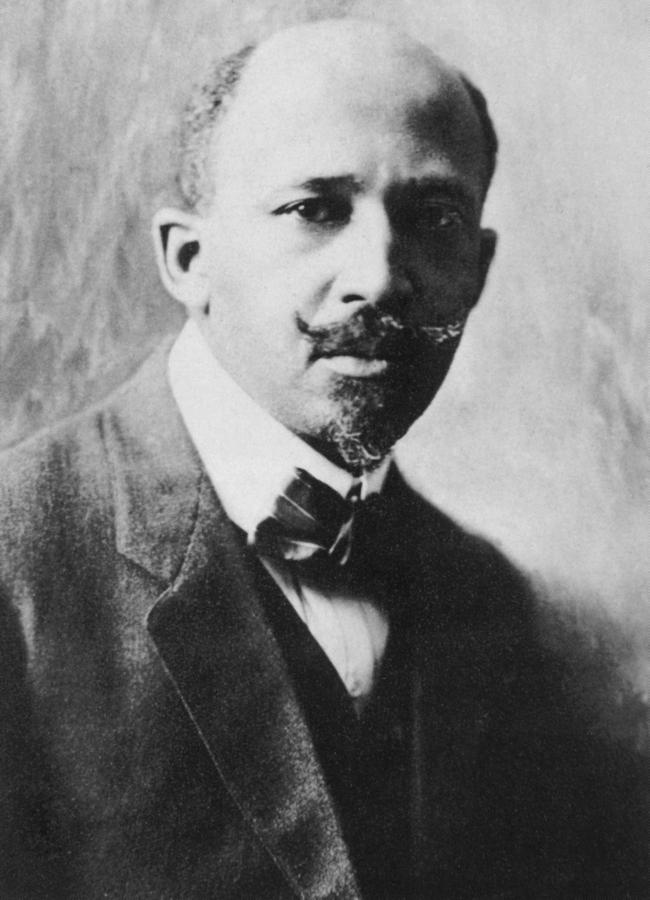 “As recently as November 1925, The New York Times had once again rejected his plea to capitalize Negro. Denial of upper-case existence in the newspaper of record merely affirmed symbolically the literal denial of the humanity of an entire race — token diminution that both reflected and sustained the cruelest beliefs and actions in the real world. The policy of the Times suited an era in which thirty-four ‘negroes’ were to be lynched in 1926. . . .”
“As recently as November 1925, The New York Times had once again rejected his plea to capitalize Negro. Denial of upper-case existence in the newspaper of record merely affirmed symbolically the literal denial of the humanity of an entire race — token diminution that both reflected and sustained the cruelest beliefs and actions in the real world. The policy of the Times suited an era in which thirty-four ‘negroes’ were to be lynched in 1926. . . .”
The Times editorialized on March 7, 1930:
“NEGRO” WITH A CAPITAL “N”
The tendency in typography is generally toward a lessened use of capital letters. Yet reverence for things held sacred by many, a regard for the fundamental law of the land, a respect for the offices of men in high authority, and certain popular and social traditions have resisted this tendency.
Races have their capitalized distinction, as have nationalities, sects and cults, tribes and clans. It therefore seems reasonable that a people who had once a proud designation, such as Ethiopians, reaching back into the dawn of history, having come up out of the slavery to which men of English speech subjected them, should now have such recognition as the lifting of the name from the lower case into the upper can give them.
Major ROBERT R. MOTON of Tuskegee, the foremost representative of the race in America, has written to THE TIMES that his people universally wish to see the word “Negro” capitalized. It is a little thing mechanically to grant, but it is not a small thing in its implications. Every use of the capital “N” becomes a tribute to millions who have risen from a low estate into “the brotherhood of the races.”
THE NEW YORK TIMES now joins many of the leading Southern newspapers as well as most of the Northern in according this recognition. In our “style book” “Negro” is now added to the list of words to be capitalized. It is not merely a typographical change; it is an act in recognition of racial self-respect for those who have been for generations in “the lower case.”
A Racist President Swept Up in the Reckoning
June 28, 2020
Activist Black Editor Would Have Exulted
All-White IRE Executive Committee Resigns
L.A. Times Moves to Settle Class-Action Bias Suit
N.Y. Times Pledges Wide-Ranging Inclusion Plan
Philadelphia Inquirer Curbs Use of ‘Redskins’
72 Percent of Blacks Approve of Protest Coverage
. . Watch Your Language in Covering Protests
. . . Seek Out Journalists of Color to Mentor
Reporter in DACA Program Can Hold Head Higher
People of Color Now Majority of Those Under 16
Where Are Strategic Thinkers on D.C. Statehood?
Short Takes
Support Journal-isms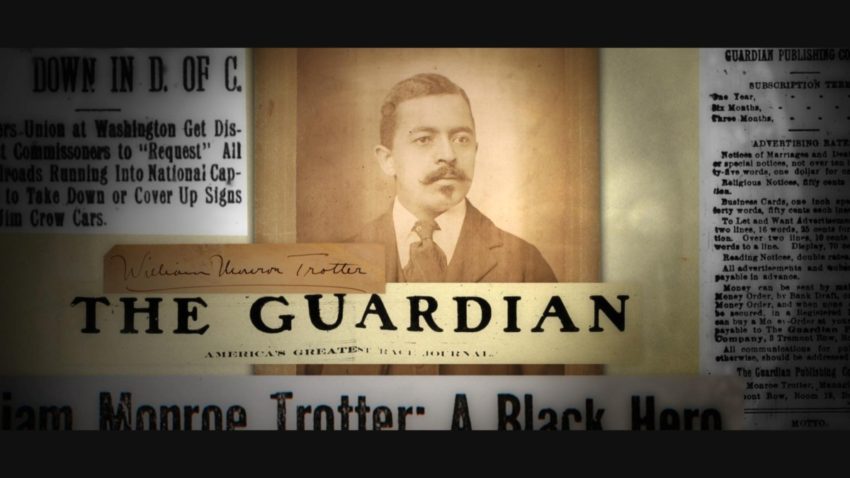
Activist Black Editor Would Have Exulted
Princeton University trustees voted to remove the name of Woodrow Wilson from its public policy school and from Wilson College, the university announced Saturday, concluding that “Wilson’s racist thinking and policies make him an inappropriate namesake for a school or college whose scholars, students, and alumni must stand firmly against racism in all its forms.”
The decision might be a fitting coda to one of the most explosive scenes in African American newspaper lore.
“On November 12, 1914, William Monroe Trotter went to the White House,” Derrick Z. Jackson wrote in 1992 in introducing the Trotter Group of African American newspaper columnists. “Trotter, editor of the Guardian newspaper, supported President Woodrow Wilson’s election. But lynching was flaring up. Federal segregation was more rigid than ever. Trotter went to ask Wilson where he stood on racism.
“Wilson told Trotter, ‘Segregation is not humiliating but a benefit . . . Your manner offends me.’
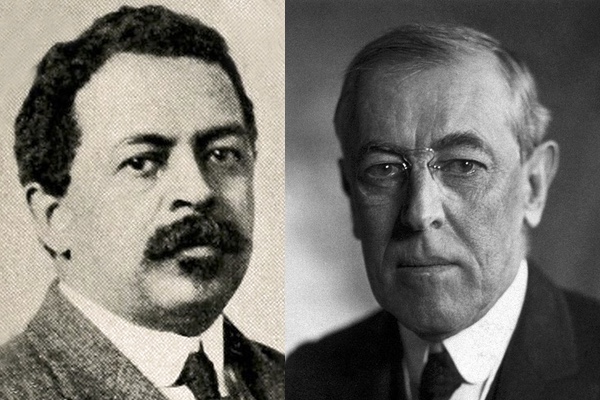 “This started a 45-minute argument. Trotter said, ‘Two years ago, you were regarded as a second Abraham Lincoln . . . Now we colored leaders (who supported Wilson), are denounced in the colored churches as traitors to our race.’ (WIlson is at right in photo, with Trotter; Credit: History News Network)
“This started a 45-minute argument. Trotter said, ‘Two years ago, you were regarded as a second Abraham Lincoln . . . Now we colored leaders (who supported Wilson), are denounced in the colored churches as traitors to our race.’ (WIlson is at right in photo, with Trotter; Credit: History News Network)
“The argument made the front page of The New York Times. The mainstream press called Trotter everything from a poor representative of his race, to possessing ‘super-abundant untactful belligerency,’ to nigger. Many African Americans publicly criticized Trotter’s judgment. . . .”
Trotter’s opposition was far from the only reason for African American disappointment in the Virginia-born Wilson, a former Princeton president. As current Princeton President Christopher L. Eisgruber said on Saturday, “Wilson’s racism was significant and consequential even by the standards of his own time. He segregated the federal civil service after it had been racially integrated for decades, thereby taking America backward in its pursuit of justice. He not only acquiesced in but added to the persistent practice of racism in this country, a practice that continues to do harm today. . . “
Eisgruber continued, “The board reconsidered these conclusions this month as the tragic killings of George Floyd, Breonna Taylor, Ahmaud Arbery, and Rayshard Brooks drew renewed attention to the long and damaging history of racism in America. Board Chair Weezie Sams ’79 and I spoke individually to members of the board, and it then met on June 26. . . .”
Journal-isms asked authors who have written about Trotter what the activist editor and publisher would make of this moment.
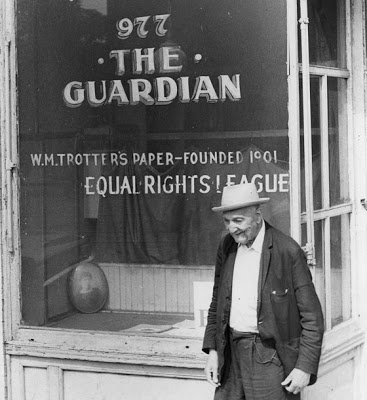
“I bet he would have rushed to put out a special edition of his paper The Guardian to announce the news with a banner headline,” messaged Dick Lehr, author of the 2014 book “The Birth of a Nation: How a Legendary Filmmaker and a Crusading Editor Reignited America’s Civil War,” about the racist film that Wilson boldly screened at the White House.
“As you know, Trotter was thrown out of the Oval Office by Wilson on November 12, 1914, for his persistence in challenging the president’s segregation of federal agencies,” Lehr messaged.
“Trotter’s wife Deenie had even prepared a hand-drawn chart showing the federal offices where the lunch rooms, bathrooms and work spaces had become segregated. The dust-up between the president and the civil rights leader made national headlines….and Trotter would certainly have made headlines out of Princeton’s decision today to remove Wilson’s name from its public policy school.”
Nicholas Patler, author of “Jim Crow and the Wilson Administration: Protesting Federal Segregation in the Early Twentieth Century,” agreed.
Patler recalled appearing at a conference at Princeton in 2006. “When it came time for my presentation, the auditorium filled up, it was packed, standing room only, and during my talk one white alum stood up and yelled at me from the audience. But the African American alumni and all the students surrounded me with such support after my talk. And then when I got home, the Dean contacted me, and explained that the students requested open dialogue based on my talk about Wilson’s racial views and how they can move forward. . . .
” I just heard from his grandniece who has co-written the screenplay with me on Trotter’s life, and she is now advocating for the change of Woodrow Wilson High School in Long Beach, California to William Monroe Trotter High School.”
- Dick Uliano, WTOP radio, Washington: DC education leaders seek name change for Woodrow Wilson High School
All-White IRE Executive Committee Resigns
The newly elected, all-white executive committee of Investigative Reporters and Editors resigned Wednesday, saying the committee’s composition “left us heartbroken and frustrated” and warranted a new election. (Scroll down)
“This result contradicts IRE’s mission. Our Bylaws, which require an immediate vote, set up a rushed process that contributed to this outcome,” they said.
The new election is scheduled for Tuesday during a livestream video meeting of the board at 4 p.m. Eastern time, Executive Director Doug Haddix announced on Friday.
While the initial June 20 election resulted in an all-white executive committee, the committee’s Wednesday letter to board colleagues noted proudly that “members of IRE elected one of the most diverse boards in its 45-year history. Seven members were elected to the board over the weekend, including three Black members, increasing representation to a total of four. In addition, women hold a board majority for the second consecutive year.”
The letter was signed by Jodi Upton, Steven Rich, Brian Rosenthal, Bethany Barnes and Jennifer LaFleur.
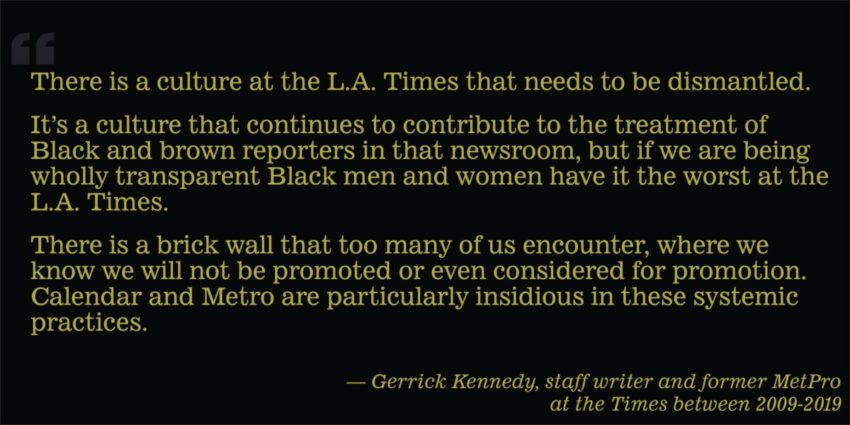
L.A. Times Moves to Settle Class-Action Bias Suit
“The Los Angeles Times is moving to settle a proposed class-action lawsuit filed by six Black, Hispanic and female journalists at the paper contending that the under-representation of people of color there is a result of longstanding discriminatory pay practices,” David Folkenflik reported Thursday for NPR.
“The civil complaint, filed in California Superior Court in San Bernardino County, outside Los Angeles, is dated June 4 but has only just surfaced in court records. A corporate spokeswoman for the L.A. Times told NPR Thursday afternoon that a settlement had been reached and that it would be submitted for the court’s preliminary approval “as soon as practical.”
“The lead complainants include journalists who have contributed to Pulitzer Prize-winning coverage at the LA Times, such as Greg Braxton, who covers television, and Bettina Boxall, a leading environmental writer. Both joined the paper in the 1980s and allege they earn far less than white and male peers with less experience. Braxton is Black; Boxall is female.
“It is the latest episode in a newsroom with a fraught history over race and gender, though the L.A. Times has twice been led by executive editors of color: Dean Baquet, who is Black, and Davan Maharaj, a journalist born in Trinidad and Tobago.
“On Tuesday, Black journalists at the Los Angeles Times called out their newspaper with the hashtag #BlackatLAT — a social media protest of what they said was a pattern of racist experiences at the paper. Scores of current and former staffers participated. . .
- Los Angeles Times Guild: Letter to Patrick Soon-Shiong from the L.A. Times Guild’s Black Caucus
N.Y. Times Pledges Wide-Ranging Inclusion Plan
The New York Times is pursuing a companywide initiative “to develop an ambitious, long-term strategy for making The Times more diverse, equitable and inclusive. . . .” company executives told staff members.
“In conversations and on Slack over the past few weeks, we have heard from many black colleagues, and other people of color around the company, that they do not feel sufficiently part of decision making, feel fully valued in our culture, or see a clear path for advancement,” the June 18 memo said. “This is something we must change.” It was signed by A.G. Sulzberger, publisher; Dean Baquet, executive editor; Meredith Kopit Levien, executive vice president and chief operating officer; and Mark Thompson, president and CEO.
 The note also said, “This work will be guided by three senior executives: Amber Guild, SVP and president, T Brand; Anand Venkatesan, SVP, Strategy and Operations; and Carolyn Ryan (pictured), assistant managing editor. Over the next month or so, they will assemble a diverse advisory council, work with experts to shape a plan and share updates about how interested colleagues can participate. And they will deliver a strategy by the end of the year, so that they have time to consult widely, consider options carefully, and build buy-in for the sustained effort and long-term commitment that will be required to drive progress.
The note also said, “This work will be guided by three senior executives: Amber Guild, SVP and president, T Brand; Anand Venkatesan, SVP, Strategy and Operations; and Carolyn Ryan (pictured), assistant managing editor. Over the next month or so, they will assemble a diverse advisory council, work with experts to shape a plan and share updates about how interested colleagues can participate. And they will deliver a strategy by the end of the year, so that they have time to consult widely, consider options carefully, and build buy-in for the sustained effort and long-term commitment that will be required to drive progress.
 “We will also take a few other actions as that broader work kicks off. The entire top of the company — executive committee members, masthead editors, desk heads and department heads — will participate in training on racial equity and inclusion. . . . “
“We will also take a few other actions as that broader work kicks off. The entire top of the company — executive committee members, masthead editors, desk heads and department heads — will participate in training on racial equity and inclusion. . . . “
“At the same time, the newsroom leadership is embarking on a major effort to ensure that The Times fulfills our commitment to diversity in every aspect of our culture and our journalism. The team will be led by two of the newsroom’s masthead leaders: Joe Kahn, managing editor, and Monica Drake (pictured), assistant managing editor. . . .”
- Apple Longform Podcast: Dean Baquet, executive editor, New York Times
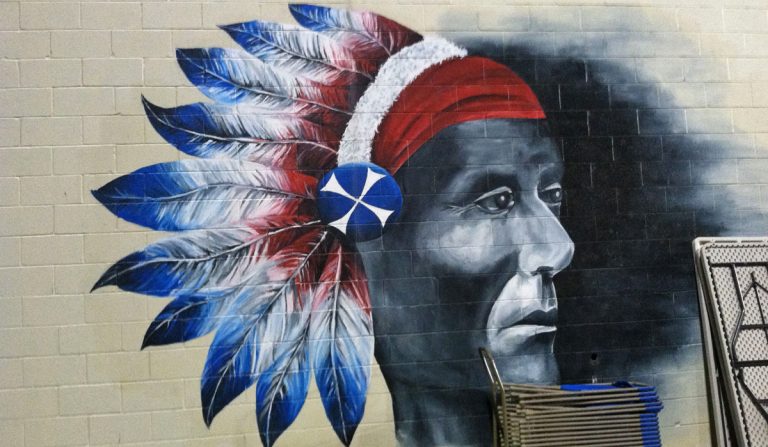 The Neshaminy School District in Bucks County, Pa., has spent roughly $435,000 defending a team name widely considered a racial slur for Native Americans, Philadelphia public radio station WHYY reported in December. “And taxpayers are on the hook for more.” (Credit: Eugene Sonn/WHYY)
The Neshaminy School District in Bucks County, Pa., has spent roughly $435,000 defending a team name widely considered a racial slur for Native Americans, Philadelphia public radio station WHYY reported in December. “And taxpayers are on the hook for more.” (Credit: Eugene Sonn/WHYY)
Philadelphia Inquirer Curbs Use of ‘Redskins’
The Philadelphia Inquirer has decided to use “Washington” and not “Redskins” to refer to the NFL team whenever possible, declaring, “While generally we should not censor what teams call themselves, imagine another ethnic slur as part of a team name.” The policy also applies to a local team, the Neshaminy Redskins in Bucks County, Pa.
Wednesday’s memo from Assistant Managing Editor David Sullivan and the newsroom Style Committee also reiterated a change in style from “black” to “Black” “as an adjective in a racial, ethnic or cultural sense, reflecting a shared identity and community rather than a skin color alone”; and offered new guidance on terms involving slavery and police shootings.
“Instead of referring to people as slaves, refer to enslaved or captive people, to emphasize that these were (and are) people forced into bondage,” the memo says. “Avoid terms such as master and slave owner; use words like enslaver or who held in slavery. Be mindful of ways that language might minimize the reality of slavery; for example, slave mistress can obscure the sexual violence involved. Avoid hyperbolic phrases with the term slave, like sex slave or slave over a hot stove.”
The committee repeated its March ruling not to use “officer-involved shooting,” or “police-involved shooting.” “Such language serves the police, not the reader, and is not the clearest way to describe what happened. While a story should note all details that led to the shooting, use a succinct sentence that clearly identifies who shot whom.”
The Native American Journalists Association has long advocated against the term “Redskins” as a team name.
As Matthew Paras reported Thursday for The Washington Times, “the NFL team on Wednesday “removed founding owner and segregationist George Preston Marshall’s name from the Ring of Fame and all other team material, such as their website and History Wall in Ashburn, Virginia. Marshall’s statue was removed last week by DC Events in a move the city called ‘overdue.’ Marshall was the last NFL owner to integrate his team, not doing so until 1962.”
The Associated Press held a Twitter discussion on style regarding racial terms on Wednesday; the tweets are collected here.
- John Eligon, New York Times: A Debate Over Identity and Race Asks, Are African-Americans ‘Black’ or ‘black’?
- Lindsey Ellefson, the Wrap: CNN to Capitalize Both ‘Black’ and ‘White’ in Reference to Race (June 18)
- Doug George-Kanentiio, indianz.com: We need African American allies to replace offensive mascots and statues
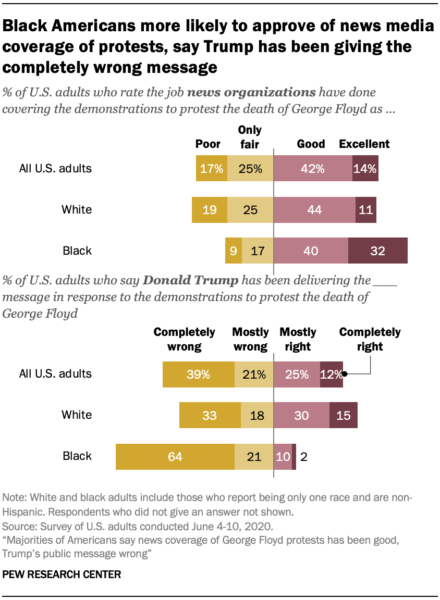
72 Percent of Blacks Approve of Protest Coverage
When it comes to news coverage of the demonstrations that followed the May 25 police killing of George Floyd, “more Americans offer a positive assessment than a negative one,” Amy Mitchell, Mark Jurkowitz, J. Baxter Oliphant and Elisa Shearer reported June 12 for the Pew Research Center. “Most U.S. adults (57%) say news organizations have done a ‘good’ or ‘excellent’ job, compared with 42% who give the news media an ‘only fair’ or ‘poor’ assessment.
“Differences in the evaluations of [President] Trump and the news media are particularly dramatic when it comes to black Americans,” the Pew report continued. “A full 85% say the message Trump has been putting out is mostly (21%) or completely wrong (64%), while only 13% say it is right. Conversely, about seven-in-ten black adults (72%) say the media have done a good or excellent job covering the demonstrations in the wake of George Floyd’s killing. . . .”
They also wrote, “Black and white adults offer varying perspectives on the amount of coverage the news media are giving to some of the storylines. For example, about half of black adults (51%) say there has been too little coverage of the decisions around whether to prosecute Minneapolis police officers for Floyd’s killing, while just 28% of white Americans ag
“A similar gap exists on the larger issue of race relations – 55% of black Americans say that subject has not been receiving enough attention, compared with 33% of white Americans who say the same. . . . .”

“Tamir Rice was also meant to turn 18 this year,” Nicquel Terry Ellis and Deborah Barfield Berry wrote Monday, updated Wednesday, for USA Today. “The 12-year-old Black child was shot to death by a police officer in November 2014 while playing with a toy gun at a park in Cleveland. . . . Ahead of what would have been Tamir’s 18th birthday on June 25, the USA TODAY Network talked to 31 teenagers about growing up Black in America. . . .”
. . . Watch Your Language in Covering Protests
“Dr. Danielle Kilgo (pictured, below) studies media portrayals of social movements . . .,” Cinnamon Janzer wrote Monday for Columbia Journalism Review.
“In a recent story for The Conversation, Kilgo compares protests including anti-Trump demonstrations and the Women’s March to those against anti-Black racism and Indigenous rights. The former, she writes, ‘gave voice to protesters and significantly explored their grievances.’ The latter, however, ‘received the least legitimizing coverage, with [protesters] more often seen as threatening and violent.’ “
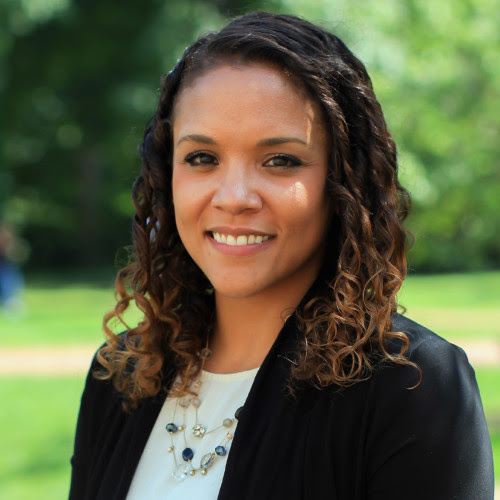 Janzer asked, “What can journalists do to begin to change the status quo?”
Janzer asked, “What can journalists do to begin to change the status quo?”
Kilgo replied, “One of the easiest choices to make is to use active voice. Police teargassed protesters. Assign entities to actions they perform. Make police responsible for their actions, just like journalists make protesters responsible for their actions.
“If you’re going to call people ‘angry protesters,’ it is so important for you to include why they’re frustrated, why they’re furious. Any time you use an emotion word, explain what’s behind that emotion to legitimize the movement as not just a bunch of angry people out on the streets making cars stop. . . .
“Sometimes you’ll get soundbites from particular protesters, but listen to multiple voices and make sure that you synthesize the real reason why people are there. Try to look for quotes that can directly articulate a grievance, demand, agenda, or all three.
“Another thing is diversifying newsrooms and editors. When the Philadelphia Inquirer‘s front page says, ‘Buildings Matter, Too,’ that cover got through a couple of editors. Diversity in the newsroom isn’t going to fix all these problems, but it could help you avoid that particular problem. . . .”
- Nicole Acevedo, NBC News: Latinos must confront ‘ingrained’ anti-black racism amid George Floyd protests, some urge (June 5, updated June 12)
- Elizabeth Alexander, The New Yorker: The Trayvon Generation: For Solo, Simon, Robel, Maurice, Cameron, and Sekou.
- Donna Britt, Washington Post: My brother was killed by police. Now I ask, who does George Floyd belong to?
- Jeffrey Gottfried and Michael Barthel, Pew Research Center: Black, Hispanic and white adults feel the news media misunderstand them, but for very different reasons
- Grace Vitaglione, Current: Station town halls on racial justice go virtual amid coronavirus concerns
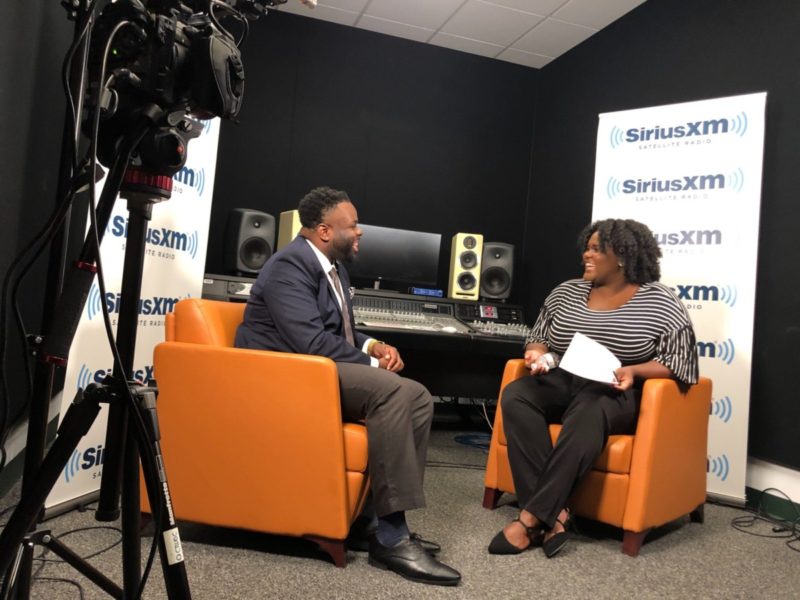
. . . Seek Out Journalists of Color to Mentor
“I am a middle-class Black woman coming from a two-parent household and I struggled to make an unpaid internship work,” Aiyana Ishmael wrote Friday for the Poynter Institute under the headline, “In 20 years I’m going to run your newsroom. Here’s how to help me get there.”
“Now imagine the hundreds of other Black student journalists who cannot dare to ask their parents to even consider letting them go. Not because it won’t be beneficial, but because it’s not in their budget.
“This is how our White counterparts get ahead. Their networking, relationship-building, and newsroom guidance starts ahead of ours, when they can afford to take financial risks like unpaid internships and commit to low-paying student newspaper jobs because their safety nets are so much larger and deeper than ours.
“But the issue doesn’t stop at unpaid internships. . . .
“This connection I built with varying journalists is the type of mentorship all Black and brown student journalists need in an industry where they’re once again the minority. Mentorship can come in all shapes and sizes — it doesn’t necessarily take a constant relationship. Sometimes all it takes is responding to an email once, meeting up for coffee, looking out for the student journalists of color in your white-washed newsroom. . . .”
- Emily Alford, Jezebel: ‘He Broke Me’: Inside the Toxic Workplace at Groundbreaking Latinx Culture Site Remezcla
- Delia Cai, Deez Links: Deez Interviews: Doris Truong, on the first real forward step every newsroom should be taking + who in the industry is doing it right (or at least getting close) (June 19)
- Jelani Cobb, Errin Haines, Rachelle Hampton, Alex Samuels, and Carvell Wallace, slate.com: “White People Don’t Respond to Our Pain; They Respond to Theirs: What it’s really like to be a Black journalist in America.”
- Scott Jones, FTV Live: A White Out in Denver
- Naomi Klinge, Los Angeles Times: Academics call on news execs to hire more Black employees
- Wesley Lowery, New York Times: A Reckoning Over Objectivity, Led by Black Journalists
- Chris Roush, Talking Biz News: Q&A: Fortune’s McGirt talks covering diversity and culture (June 19)
- Amanda Zamora, Poynter Institute: Overcoming systemic racism begins in our own newsrooms

Reporter in DACA Program Can Hold Head Higher
The June 18 Supreme Court ruling upholding the Deferred Action for Childhood Arrivals program “gave me peace and a sense of relief knowing that I can continue living and working in this country as a reporter for The San Diego Union-Tribune,” Andrea Lopez-Villafaña wrote that day for the Union-Tribune.
“I can continue covering the stories of San Diego’s neighborhoods and doing my part to highlight inequity in our communities through storytelling.
“I moved to the U.S. when I was about 5 years old. My parents decided to leave Mexico after my dad lost his job as a security guard for the mayor of the city of Tlaquepaque. . . .
“I applied for DACA my junior year of high school and was accepted. . . .
“While I was being granted an opportunity to achieve the American Dream, my dad was being taken away from the only life he knew for more than 15 years. He was deported a day before my high school graduation and although he lives in Tijuana, less than 30 minutes from my Barrio Logan apartment, I can’t visit him because of my immigration status.
“I’ve worked in journalism for the last three years and have had the tremendous opportunity to cover stories of individuals and communities in San Diego. I know the fight is not over, but at least today I can pick up my head a little higher knowing that I’m safe for now.
“There is a long road ahead for the thousands of DACA recipients with stories like mine.”
- James Goodman, The Progressive: The Essential, the Undocumented: COVID-19 exposes the fallacy and danger of Donald Trump’s anti-immigrant crusade. (June 16)
People of Color Now Majority of Those Under 16
“For the first time, nonwhites and Hispanics were a majority of people under age 16 in 2019, an expected demographic shift that will grow over the coming decades, according to figures released by the U.S. Census Bureau on Thursday,” Mike Schneider reported for the Associated Press.
” ‘We are browning from bottom up in our age structure,’ said William Frey, a senior fellow at The Brookings Institution. ‘This is going to be a diversified century for the United States, and it’s beginning with this youngest generation.’
“At the same time, the number of non-Hispanic whites in the U.S. has gotten smaller in the past decade as deaths surpassed births in this aging demographic, according to the Census Bureau population estimates. . . .”
Where Are Strategic Thinkers on D.C. Statehood?
 We’re missing Cokie Roberts’ political smarts. In a historic vote, the House of Representatives voted nearly along party lines on Friday to grant statehood to Washington, D.C., the first time a chamber of Congress has approved establishing the nation’s capital as a state. (Pictured: facemask with D.C. flag )
We’re missing Cokie Roberts’ political smarts. In a historic vote, the House of Representatives voted nearly along party lines on Friday to grant statehood to Washington, D.C., the first time a chamber of Congress has approved establishing the nation’s capital as a state. (Pictured: facemask with D.C. flag )
If approved, “Washington, Douglass Commonwealth” would become the state with the largest percentage of African Americans, but the measure is expected to die in the Senate.
In a 2014 appearance at the National Archives, Roberts, the late ABC News and NPR commentator who died in September at 75, was asked what strategies D.C. might use to win statehood. Roberts and her co-panelist, Todd S. Purdum, formerly of the New York Times, invoked what apparently no one today is thinking about: history.
“What it would take is the District turning Republican,” Roberts said, noting that the District would surely add two more Democratic seats to the Senate, which Republicans would never approve.
Then Purdum recalled that Arizona and New Mexico, admitted to the union in 1912, were originally supposed to be one state. But Congress, realizing that this new state would probably be Republican, agreed to admit them as two states instead, so as to give the Democrats a chance. Today, New Mexico has two Democratic senators; Arizona has one Republican and one Democrat.
Who among commentators, let alone politicians, is thinking about old-fashioned horse trading?
- Karen Tumulty, Washington Post: Why the lopsided House vote in favor of D.C. statehood was so historic
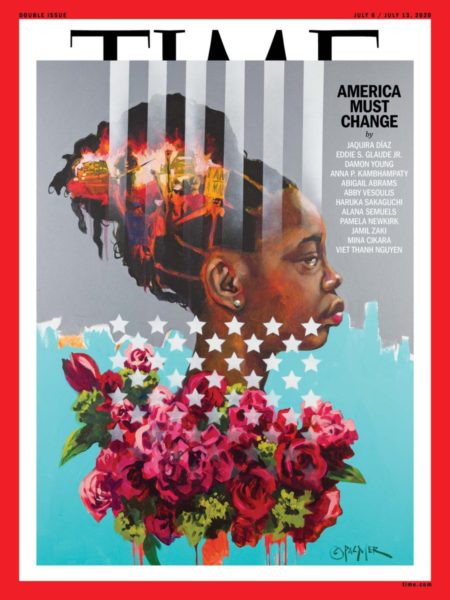
Short Takes
- “The Tennessean newspaper and Gannett, its parent company, fired an advertising manager on Monday, a day after the newspaper published a full-page ad from a biblical prophecy group claiming ‘Islam’ would detonate a bomb in Nashville,” Aimee Ortiz reported for The New York Times.
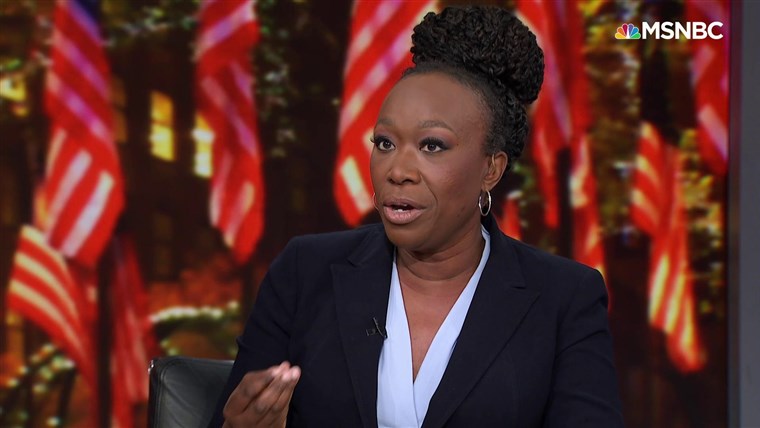 MSNBC is not commenting on a report by the Wall Street Journal, updated Wednesday, that “MSNBC is expected to tap political analyst Joy Reid (pictured) to anchor a 7 p.m. daily news and opinion program . . . filling the vacancy created at the cable news channel when Chris Matthews resigned abruptly in March.” The information for the story by Joe Flint, (paywall), picked up by other outlets, was attributed to “people familiar with the matter.”
MSNBC is not commenting on a report by the Wall Street Journal, updated Wednesday, that “MSNBC is expected to tap political analyst Joy Reid (pictured) to anchor a 7 p.m. daily news and opinion program . . . filling the vacancy created at the cable news channel when Chris Matthews resigned abruptly in March.” The information for the story by Joe Flint, (paywall), picked up by other outlets, was attributed to “people familiar with the matter.”
- “YouTube has established a $100 million fund to support black creators and artists utilising the Google-owned video platform,” James Pearce reported June 15 foe IBC365, an online community platform. “The multiyear fund is dedicated to ‘amplifying and developing the voices of Black creators and artists and their stories,’ according to CEO Susan Wojcicki,” Pearce wrote.
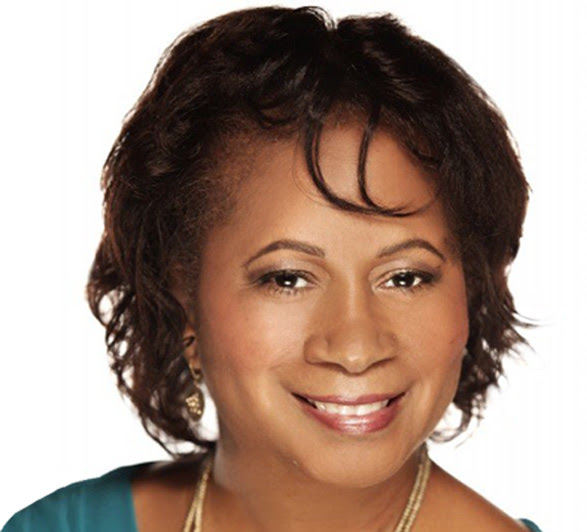 Jacquie Gales Webb (pictured), who has “managed grants that have touched the lives of many Americans, including StoryCorps’ Mobile Booth and One Small Step projects, WGBH’s WORLD Channel, [and] the Urban Alternative music format,” has been “named as Vice President, Radio of the Corporation for Public Broadcasting,” CPB announced on Monday. Webb is “responsible for developing and implementing strategies to strengthen the ability of public radio stations to create high-quality, multiplatform content and to grow their audiences. . . .”
Jacquie Gales Webb (pictured), who has “managed grants that have touched the lives of many Americans, including StoryCorps’ Mobile Booth and One Small Step projects, WGBH’s WORLD Channel, [and] the Urban Alternative music format,” has been “named as Vice President, Radio of the Corporation for Public Broadcasting,” CPB announced on Monday. Webb is “responsible for developing and implementing strategies to strengthen the ability of public radio stations to create high-quality, multiplatform content and to grow their audiences. . . .”
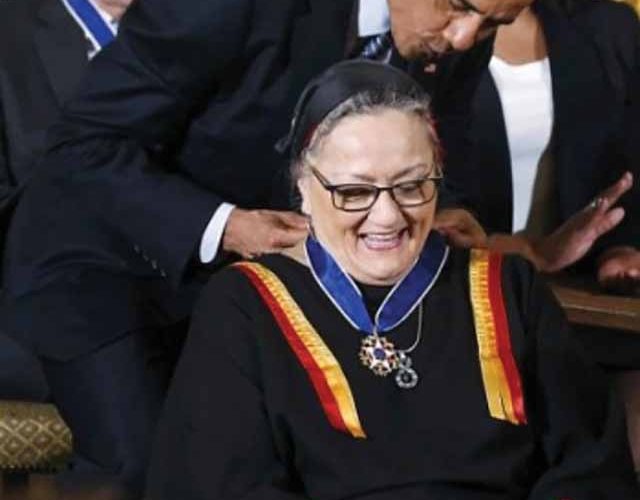
Suzan Shown Harjo receives the Presidential Medal of Freedom in 2014 from President Barack Obama. (Credit: Duke Ray Harjo II.)
- “Suzan Shown Harjo has been at the forefront of every major Indian Country battle,” Acee Agoyo reported Monday for indianz.com. “From protecting sacred sites to addressing cultural appropriation and racist mascots, the Presidential Medal of Freedom recipient has seen it all and has been celebrated for her role in advancing tribal causes. . . .Over the last two months, she’s tested positive not once, but twice, for COVID-19, the disease caused by the novel coronavirus. But as she spoke via phone from the nation’s capital, Harjo sounded as strong as ever. She said she has been asymptomatic, meaning she hasn’t experienced a high fever, shortness of breath or any of the conditions associated with the virus. ‘I feel fine,’ Harjo told Indianz.Com on Sunday. She repeated her assessment: “I feel fine.’ . . .”
 “Jemele Hill (pictured, right) and Cari Champion both worked at ESPN,” Brian Steinberg wrote Wednesday for Variety. “Now they have a new chance to band together. The pair will host a new weekly talk show, ‘Disruptors with Jemele Hill and Cari Champion,’ slated to debut this summer on Vice TV. Over an initial order of eight episodes, the show aims to unpack the biggest topics and headlines of the week from the worlds of culture, politics, sports and business. . . .”
“Jemele Hill (pictured, right) and Cari Champion both worked at ESPN,” Brian Steinberg wrote Wednesday for Variety. “Now they have a new chance to band together. The pair will host a new weekly talk show, ‘Disruptors with Jemele Hill and Cari Champion,’ slated to debut this summer on Vice TV. Over an initial order of eight episodes, the show aims to unpack the biggest topics and headlines of the week from the worlds of culture, politics, sports and business. . . .”
- Linda Tirado, a journalist “who was covering the recent rioting in Minneapolis alleges in a lawsuit that law enforcement blinded her in one eye with a nonlethal projectile fired at her despite her declaring in words and documentation that she was a member of the news media,” Paul Walsh reported June 16 for the Star Tribune in Minneapolis.
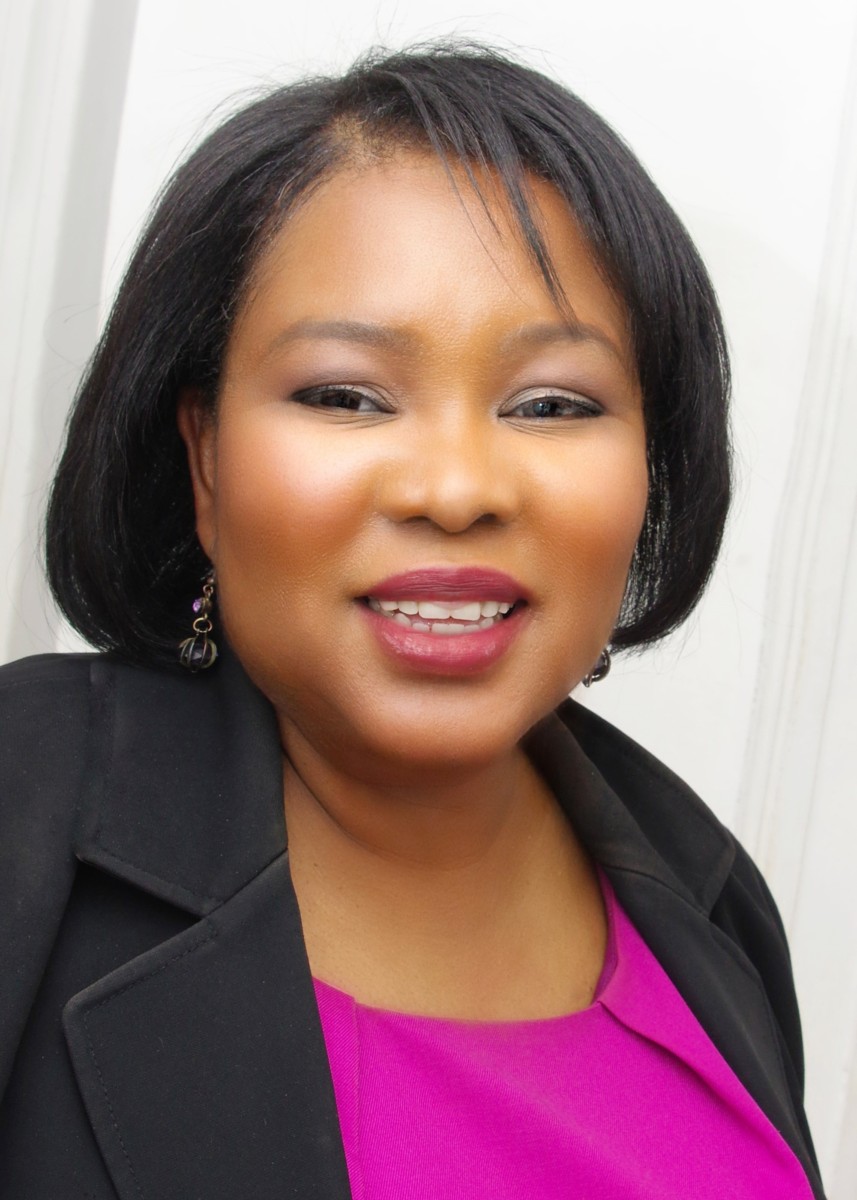 ““FOX News Channel (FNC) has promoted Patricia Peart (pictured) to Vice President of Weekend Booking, effective immediately,” the network announced Wednesday. “In this capacity, she will continue to manage the network’s weekend breaking news coverage as well as oversee guest booking across all FNC’s weekend programming, reporting to David Clark, Senior Vice President of Weekend News and Programming. . . .”
““FOX News Channel (FNC) has promoted Patricia Peart (pictured) to Vice President of Weekend Booking, effective immediately,” the network announced Wednesday. “In this capacity, she will continue to manage the network’s weekend breaking news coverage as well as oversee guest booking across all FNC’s weekend programming, reporting to David Clark, Senior Vice President of Weekend News and Programming. . . .”
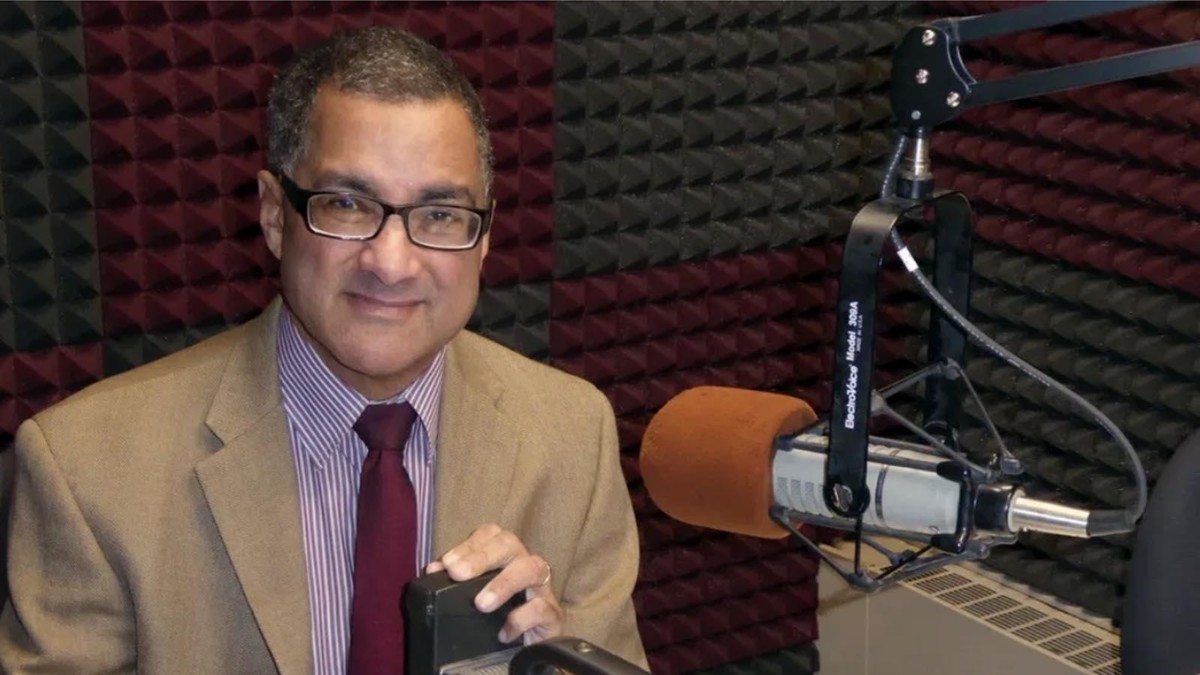 Robin Washington (pictured), veteran journalist whose portfolio includes host/producer, Wisconsin Public Radio, is calling out Jewish organizations who have supported Black Lives Matter movements. “Yet not a single one of those organizations has made a serious effort to fully empower African-American Jews within the Jewish community,” Washington, who has helped organize black Jews, wrote. “And not a single one has a Black Jew on its board of directors. Nor do 48 out of the 51 member groups in the Conference of Presidents of Major American Jewish Organizations. The only two that do are the American Sephardi Federation (which by definition is inclusive of Jews of African descent) and the Union for Reform Judaism, which has a single Black Jewish member among its massive board of more than 250. . . .”
Robin Washington (pictured), veteran journalist whose portfolio includes host/producer, Wisconsin Public Radio, is calling out Jewish organizations who have supported Black Lives Matter movements. “Yet not a single one of those organizations has made a serious effort to fully empower African-American Jews within the Jewish community,” Washington, who has helped organize black Jews, wrote. “And not a single one has a Black Jew on its board of directors. Nor do 48 out of the 51 member groups in the Conference of Presidents of Major American Jewish Organizations. The only two that do are the American Sephardi Federation (which by definition is inclusive of Jews of African descent) and the Union for Reform Judaism, which has a single Black Jewish member among its massive board of more than 250. . . .”
- The Washington Post, which has promised a major effort toward diversity and inclusion, including more than a dozen new positions focused on race, has posted job openings on its website, including one for managing editor for diversity and inclusion.
- Sinclair Broadcast Group announced June 17 that it will be launching a headline news service scheduled to premiere in early 2021. “As part of this effort, the company also announced it will be hiring 25 new positions to staff this new initiative [PDF]. . . . In the initial phase, the headline news service will air weekday mornings from 6:00 – 9:00 a.m. across Sinclair’s CW and MY network affiliates, as well as on STIRR, Sinclair’s free, over-the-top streaming platform. . . .”
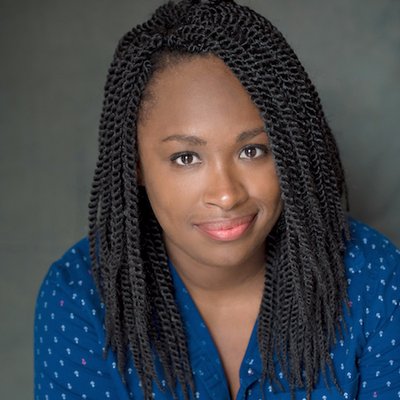 “NBC News Digital announced today that Michelle Garcia (pictured) is joining NBC News as the new editorial director for NBCBLK — NBC News’ African-American news vertical on NBCNews.com,” A.J. Katz reported Friday for adweek.com. The NBC announcement said, “Michelle was most recently a deputy editor at Vice.com, where she managed the issues desk and its team of 12 covering health policy, the environment, the economy, and identities, including a lengthy investigation into the Flint water crisis. She has also been managing editor of Out magazine, senior editor for race and identities at Vox.com, identities editor at Mic.com, and managing editor of Advocate.com. . ..” MIchael Cottman, who had been leading the site on an interim basis, will remain as a contributor, an NBC spokeswoman said.
“NBC News Digital announced today that Michelle Garcia (pictured) is joining NBC News as the new editorial director for NBCBLK — NBC News’ African-American news vertical on NBCNews.com,” A.J. Katz reported Friday for adweek.com. The NBC announcement said, “Michelle was most recently a deputy editor at Vice.com, where she managed the issues desk and its team of 12 covering health policy, the environment, the economy, and identities, including a lengthy investigation into the Flint water crisis. She has also been managing editor of Out magazine, senior editor for race and identities at Vox.com, identities editor at Mic.com, and managing editor of Advocate.com. . ..” MIchael Cottman, who had been leading the site on an interim basis, will remain as a contributor, an NBC spokeswoman said.
- The Society of Professional Journalists and Radio Television Digital News Association’s joint convention this year will be virtual due to the coronavirus, the groups announced. The virtual conference is planned for Sept. 12 and 13 in lieu of the in-person Excellence in Journalism event that was scheduled for Washington, D.C.
- Rep. Alexandria Ocasio-Cortez, D-N.Y., easily won her primary Tuesday, defeating Michelle Caruso-Cabrera, her Wall Street-backed challenger and former CNBC correspondent, Latino Rebels reported Wednesday.
 MJ Franklin (pictured) will be joining the New York Times Book Review as an assistant preview editor, “where he will be working with the Book Review editorial team to assign and edit fiction and nonfiction reviews,” the Times announced Tuesday. “MJ will help cover literary fiction, memoir and essays, and he’ll lead our coverage of the booming young adult category. . . .”
MJ Franklin (pictured) will be joining the New York Times Book Review as an assistant preview editor, “where he will be working with the Book Review editorial team to assign and edit fiction and nonfiction reviews,” the Times announced Tuesday. “MJ will help cover literary fiction, memoir and essays, and he’ll lead our coverage of the booming young adult category. . . .”
 Authorities in Barbados must thoroughly investigate the killing of photojournalist Christoff Griffith (pictured) and ensure that those responsible are held to account, the Committee to Protect Journalists said Friday. “Griffith is the first journalist CPJ has recorded as killed in relation to his work in Barbados. On June 22, in St. Michael, southwest Barbados, an unidentified man attacked and killed Griffith, a photojournalist working with The Nation newspaper, according to news reports and Carol Martindale, executive director of The Nation, who spoke to CPJ in a phone interview. Griffith had traveled to the area to cover a crime scene; he arrived before police, and was killed by the suspected perpetrator of the original crime. . . .”
Authorities in Barbados must thoroughly investigate the killing of photojournalist Christoff Griffith (pictured) and ensure that those responsible are held to account, the Committee to Protect Journalists said Friday. “Griffith is the first journalist CPJ has recorded as killed in relation to his work in Barbados. On June 22, in St. Michael, southwest Barbados, an unidentified man attacked and killed Griffith, a photojournalist working with The Nation newspaper, according to news reports and Carol Martindale, executive director of The Nation, who spoke to CPJ in a phone interview. Griffith had traveled to the area to cover a crime scene; he arrived before police, and was killed by the suspected perpetrator of the original crime. . . .”
- ”John Bompengo, who covered Congo’s political turmoil as a freelance photographer and video journalist for The Associated Press over the course of 16 years has died, relatives said Sunday,” Krista Larson reported for the AP on Monday. “He was 52. The cause of death was complications due to the coronavirus. Bompengo had been hospitalized for about a week but his condition rapidly deteriorated Friday and he died the following day. Bompengo had contributed to AP since 2004, including coverage of the Ebola outbreak in northern Congo, in 2018. . . .”
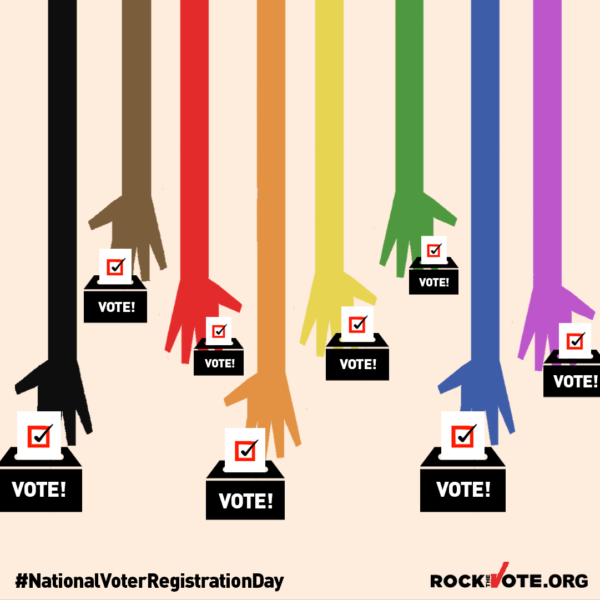
Rock the Vote, a nonpartisan organization that is working with businesses and influencers, has asked Journal-isms to help publicize its National Voter Registration Day, to take place Sept. 22.
Facebook users: “Like” “Richard Prince’s Journal-isms” on Facebook.
Follow Richard Prince on Twitter @princeeditor
Richard Prince’s Journal-isms originates from Washington. It began in print before most of us knew what the internet was, and it would like to be referred to as a “column.” Any views expressed in the column are those of the person or organization quoted and not those of any other entity. Send tips, comments and concerns to Richard Prince at journal-isms-owner@yahoogroups.com
View previous columns (after Feb. 13, 2016).
- Diversity’s Greatest Hits, 2018 (Jan. 4, 2019)
- Book Notes: Is Taking a Knee Really All That? (Dec. 20, 2018)
- Book Notes: Challenging ’45’ and Proudly Telling the Story (Dec. 18, 2018)
- Book Notes: Get Down With the Legends! (Dec. 11, 2018)
- Journalist Richard Prince w/Joe Madison (Sirius XM, April 18, 2018) (podcast)
- Richard Prince (journalist) (Wikipedia entry)
- February 2018 Podcast: Richard “Dick” Prince on the need for newsroom diversity (Gabriel Greschler, Student Press Law Center, Feb. 26, 2018)
- Diversity’s Greatest Hits, 2017 — Where Will They Take Us in the Year Ahead?
- Book Notes: Best Sellers, Uncovered Treasures, Overlooked History (Dec. 19, 2017)
- An advocate for diversity in the media is still pressing for representation, (Courtland Milloy, Washington Post, Nov. 28, 2017)
- Morgan Global Journalism Review: Journal-isms Journeys On (Aug. 31, 2017)
- Diversity’s Greatest Hits, 2016
- Book Notes: 16 Writers Dish About ‘Chelle,’ the First Lady
- Book Notes: From Coretta to Barack, and in Search of the Godfather
- Journal-isms’ Richard Prince Wants Your Ideas (FishbowlDC, Feb. 26, 2016)
- “JOURNAL-ISMS” IS LATEST TO BEAR BRUNT OF INDUSTRY’S ECONOMIC WOES (Feb. 19, 2016)
- Richard Prince with Charlayne Hunter-Gault,“PBS NewsHour,” “What stagnant diversity means for America’s newsrooms” (Dec. 15, 2015)
- Book Notes: Journalists Follow Their Passions
- Book Notes: Journalists Who Rocked Their World
- Book Notes: Hands Up! Read This!
- Book Notes: New Cosby Bio Looks Like a Best-Seller
- Journo-diversity advocate turns attention to Ezra Klein project (Erik Wemple, Washington Post, March 5, 2014)
